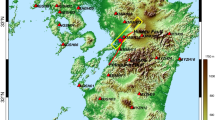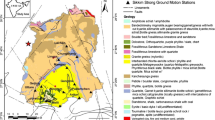Abstract
In the present work, ground motion is estimated from future scenario earthquakes at different sites in Uttarakhand Himalayas in India using empirical Green’s function (EGF) technique. The recorded ground motion from April 4, 2011, M w 5.4 earthquake is taken as a basic element. The ground motion is estimated at 24 sites, where the element earthquake was recorded. It is observed from synthesized time histories that sites located near the epicenter may expect accelerations in excess of 1 g. In the present analysis, Dharchula can expect ground accelerations in excess of 1 g. For M w 7.0, the expected peak values of acceleration (A max) and velocity (V max) on horizontal components at different sites range between 11 and 912 gal and 5 and 52 cm/s, respectively. The corresponding values for the Z component range between 8 and 228 gal, and 3 and 14 cm/s, respectively. Similarly, for M w 7.5, the expected A max and V max on horizontal components at different sites range between 25 and 1281 gal and 25 and 102 cm/s, respectively. The corresponding values for the Z component range between 14 to 474 gal, and 15 to 70 cm/s, respectively. The site amplification functions are estimated using the horizontal-to-vertical spectral ratio procedure. Zone IV (on a scale of II to V according to the seismic zonation map for India) response spectrum for 5 % damping is deficient for M w 7.0, while zone V response spectrum is exceeded at several frequencies for same magnitude. For M w 7.5, zone IV response spectrum is conservative (except at some frequencies), while zone V response spectrum is exceeded at many sites. The estimated PGA values can be incorporated in marking the weak areas in the central Himalaya, thereby assisting the designing and construction of new structures.












Similar content being viewed by others
References
Ambraseys N, Jackson D (2003) A note on early earthquakes in Northern India and Southern Tibet. Curr Sci 84(4):570–582
Beresnev IA, Nightengale AM, Walter J, Silva WJ (2002) Properties of vertical ground motions. Bull Seismol Soc Am 92:3152–3164
Bilham R (1995) Location and magnitude of the Nepal earthquake and its relation to the rupture zones of the contiguous great Himalayan earthquakes. Curr Sci 69:101–128
Bilham R (2004) Earthquakes in India and the Himalaya: tectonics, geodesy and history. Ann Geophys 47(2/3):839–858
Bilham R, Gaur VK (2000) The geodetic contribution to Indian seismotectonics. Curr Sci 79:1259–1269
BIS IS 1893 (2002) (Part 1). Indian standard criteria for earthquake resistant design of structures, part 1—general provisions and buildings. Bureau of Indian Standards, New Delhi, p. 39
Boore DM (1983) Stochastic simulation of high–frequency ground motions based on seismological models of the radiated spectra. Bull Seism Soc Am 73:1865–1884
Boore DM (1986) The effect of finite bandwidth on seismic scaling relationships, in earthquake source mechanics, S. Das, J. Boatwright, and C. Scholz (editors). Am Geophysical 37:275–283
Borcherdt RD (1970) Effects of local geology on ground motion near San Francisco Bay. Bull Seism Soc Am 60:29–61
Cartwright DE, Longuet-Higgins MS (1956) The statistical distribution of the maxima of a random function. Proc Roy Soc London, Ser A237:212–232
Chen W, Molnar P (1983) Focal depths of intracontinental and intraplate earthquakes and their implications for the thermal and mechanical properties of the lithosphere. J Geophys Res 88:4183–4214
Hanks TC, Mcguire RK (1981) The character of high-frequency strong ground motion. Bull Seism Soc Am 71:2071–2095
Hartzell S (1978) Earthquake aftershock as Green’s functions. Geophys Res Lett 5:1–4
Herrmann RB (1985) An extension of random vibration theory estimates of strong ground motion at large distances. Bull Seism Soc Am 75:1447–1453
Irikura K (1983) Semi-empirical estimation of strong ground motions during large earthquakes. Bulletin of Disaster Prev Res Institute, Kyoto Univ 32:63–104
Kayal JR (2008) Microearthquake seismology and seismotectonics of South Asia. Springer, 504p
Khattri KN (1987) Great earthquakes, seismicity gaps and potential tor earthquake disaster along the Himalaya plate boundary. Tectonophysics 138:79–92
Khattri KN (1999) An evaluation of earthquakes hazard and risk in Northern India. Himal Geol 20:1–46
Khattri KN, Chander R, Gaur VK, Sarkar I, Kumar S (1989) New seismological results on the tectonics of the Garhwal Himalaya. Proc Indian Acad Sci ( Earth Planet Sci.) 98:91–109
Konno K, Ohmachi T (1998) Ground-motion characteristics estimated from spectral ratio between horizontal and vertical components of microtremor. Bull Seism Soc Am 88(1):228–241
Kumar A, Mittal H, Sachdeva R, Kumar A (2012) Indian strong motion instrumentation network. Seismol Res Lett 83(1):59–66
Kumar N, Sharma J, Arora BR, Mukopadhyay S (2009) Seismotectonic model of the Kangra-Chamba sector of Northwest Himalaya: constraints from joint hypocenter determination and focal mechanism. Bull Seism Soc Am 99:95–109
Lermo J, Chavez-Garcia FJ (1993) Site effect evaluation using spectral ratios with only one station. Bull Seism Soc Am 83:1574–1594
Liang X, Zhou S, Chen YJ, Jin G, Xiao L, Liu P, Fu Y, Tang Y, Lou X, Ning J (2008) Earthquake distribution in Southern Tibet and its tectonic implications. J Geophys Res 113(B12409):11. doi:10.1029/2007JB005101
Loukachev I, Pralle N, Gudehus G (2002) Dilatancy-induced P waves as evidence for nonlinear soil behavior. Bull Seism Soc Am 92:854–862
Mittal H, Kumar A (2015) Stochastic finite-fault modeling of Mw 5.4 earthquake along Uttarakhand–Nepal border. Nat Hazards 75(2):1145–1166
Mittal H, Kamal K, Kumar A, Singh SK (2013a) Estimation of site effects in Delhi using standard spectral ratio. Soil Dyn Earthq Eng 50:53–61
Mittal H, Kumar A, Kamal (2013b) Ground motion estimation in Delhi from postulated regional and local earthquakes. J Seismol 17(2):593–605
Mittal H, Kumar A, Kumar A (2013c) Site effects estimation in Delhi from the Indian strong motion instrumentation network. Seismol Res Lett 84(1):33–41
Mittal H, Kumar A, Ramhmachhuani R (2012) Indian national strong motion instrumentation network and site characterization of its stations. Int J Geosci 3(6):1151–1167
Mittal H, Kumar A, Kumar A, Kumar R (2015) Analysis of ground motion in Delhi from earthquakes recorded by strong motion network. Arab J Geosci 8(4):2005–2017
Mittal H, Wu YM, Chen DY, Chao WA (2016) Stochastic finite modeling of ground motion for March 5, 2012, Mw 4.6 earthquake and scenario greater magnitude earthquake in the proximity of Delhi. Nat Hazards. doi:10.1007/s11069-016-2236-x
Monsalve G, Sheehan A, Schulte-Pelkum V, Rajaure S, Pandey MR, Wu F (2006) Seismicity and one dimensional velocity structure of the Himalayan collision zone: earthquakes in the crust and upper mantle. J Geophys Res 111:B10301. doi:10.1029/2005JB004062
Nakamura Y (1989) A method for dynamic characteristics estimations of subsurface using microtremors on the ground surface. QR RTRI 30:25–33
Ni J, Barazangi M (1984) Seismotectonics of the himalayan collision zone: geometry of the underthrusting Indian plate beneath the Himalaya. J Geophys Res 89:1147–1163
Ordaz M, Arboleda J, Singh SK (1995) A scheme of random summation of an empirical Green’s function to estimate ground motions from future large earthquakes. Bull Seism Soc Am 85:1635–1647
Seeber L, Armbruster JG (1981) Great detachment earthquakes along the Himalayan arc and long-term forecasting, in earthquake prediction: an international review. Maurice Ewing Series 4, American Geophysical Union, Washington, D.C., pp. 259–277
Sharma B, Chopra S, Sutar AK, Bansal BK (2013) Estimation of strong ground motion from a great earthquake mw 8.5 in central seismic gap region, Himalaya (India) using empirical Green’s function technique. Pure Appl Geophys 170(12):2127–2138
Sharma B, Chopra S, Kumar V (2016) Simulation of strong ground motion for 1905 Kangra earthquake and a possible megathrust earthquake (Mw 8.5) in western Himalaya (India) using Empirical Green’s Function technique. Nat Hazards 80(1):487–503
Singh SK, Mohanty WK, Bansal BK, Roonwal GS (2002) Ground motion in Delhi from future large/great earthquakes in the central seismic gap of the Himalayan arc. Bull Seism Soc Am 92:555–569
Singh SK, Ordaz M, Dattatrayam RS, Gupta HK (1999) A spectral analysis of the 21 May 1997, Jabalpur, India, earthquake (Mw = 5.8) and estimation of ground motion from future earthquakes in the Indian shield region. Bull Seism Soc Am 89:1620–1630
Sokolov VY, Loh C-H, Jean W-Y (2007) Application of horizontal-to-vertical (H/V) Fourier spectral ratio for analysis of site effect on rock (NEHRP-class B) sites in Taiwan. Soil Dynan Earthq Eng 27:314–323
Steidl JH, Tumarkin AG, Archuleta RJ (1996) What is a reference site? Bull Seism Soc Am 86:1733–1748
Tohdo M, Hatori T, Chiba O, Takahashi K, Takemura M, Tanaka H (1995) Characteristics of vertical seismic motions and Qp-values in sedimentary layers. J Struct Constr Eng Trans Architectural Inst Japan 475:45–54(in Japanese with English abstract)
Toro G, Mcguire R (1987) An investigation into earthquake ground motion characteristics in Eastern North America. Bull. Seism. Soc. Am. 77:468–489
Valdiya KS (1980) Geology of Kumaun Lesser Himalaya. Dehradun. Wadia Institute of Himalayan Geology, Dehradun, India, Interim Record, p. 291
Wessel P, Smith WHF (1998) New improved version of generic mapping tools. EOS Trans Am Geophys Union 79(47):579
Yin A (2006) Cenozoic tectonic evolution of the Himalayan orogen as constrained by along strike variation of structural geometry, exhumation history and foreland sedimentation. Earth Sci Rev 76:1–132
Acknowledgments
The authors are profusely thankful to Prof. S.K. Singh, Instituto de Geofisica, Universidad, Nacional Autonoma de Mexico (UNAM) for providing the codes of his program. The authors are thankful to Ministry of Earth Science (MoES), Government of India and Ministry of Science and Technology, Republic of China, for funding projects under which this research and revision of manuscript was carried out. We are also very thankful to editor-in-chief, Abdullah M. Al-Amri for his valuable revision, which helped us to clarify and improve this paper. Comments from an anonymous reviewer helped in improving the manuscript. The strong motion data from IITR network is freely available from website www.pesmos.in (last accessed January 2015) to the registered users. We acknowledge the IITR network for the same. The GMT software from Wessel and Smith (1998) was used in plotting part of the figures and is gratefully acknowledged.
Author information
Authors and Affiliations
Corresponding author
Rights and permissions
About this article
Cite this article
Mittal, H., Kumar, A., Wu, YM. et al. Source study of M w 5.4 April 4, 2011 India–Nepal border earthquake and scenario events in the Kumaon–Garhwal Region. Arab J Geosci 9, 348 (2016). https://doi.org/10.1007/s12517-016-2330-0
Received:
Accepted:
Published:
DOI: https://doi.org/10.1007/s12517-016-2330-0




